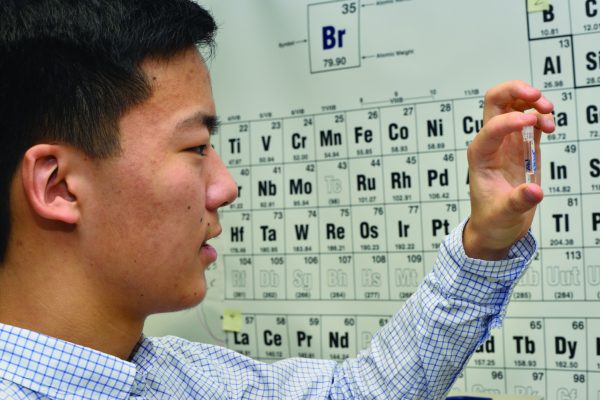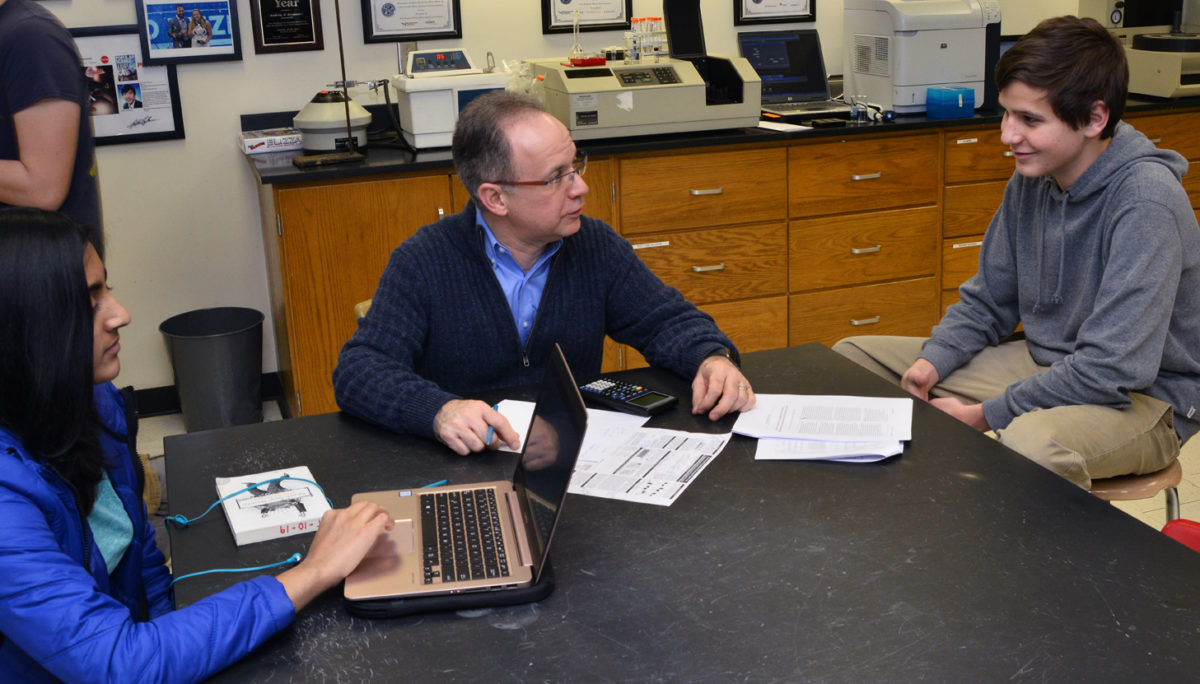AÂ machine learning tool that can detect small-cell lung cancer. A computational model demonstrating the effect of carbon tax policies on the global agricultural economy. A high-performance biodegradable battery for transient electronics.
These are just a few of the 40 student-led research projects chosen as finalists in the Regeneron Science Talent Search, a science and math competition for high school seniors.
The competition is the result of an inaugural partnership between Tarrytown-based Regeneron Pharmaceuticals Inc. and Society for Science and the Public, a nonprofit in Washington, D.C., that has produced and organized the Science Talent Search since its founding in 1942.
“We thought it was important (to partner with the Society for Science and the Public) because it was an incredible opportunity to support scientific talent in our country,” said Potoula Gjidija, associate director of corporate citizenship at Regeneron. “We believe this talent search is a gateway to careers in the sciences.”

The competition also holds a special significance for Dr. George Yancopoulos, Regeneron”™s founding scientist and chief scientific officer, and Dr. Leonard S. Schleifer, Regeneron”™s CEO who founded the company in 1988. Both are alumni of the Science Talent Search, selected when they were in high school in the 1970s.
“For them, it was a really important avenue to give back to the Science Talent Search because they credit that experience with having really cemented their science career path,” Gjidija said.
Regeneron took over the title sponsorship role of the talent search from Intel Corp., which sponsored the competition for 18 years. Prior to that, Westinghouse Electric Corp. was lead sponsor of the Science Talent Search from its inception in 1942.
Regeneron, New York state”™s largest and fastest-growing biopharmaceutical employer, is backing its commitment to the competition with $100 million in funding over 10 years. Gjidija said the company believes the contest showcases the critical role science plays in society.
“By aligning with the Science Talent Search, we believe that together with the Society for Science and the Public, we can recognize the best and brightest young minds and really help to energize that talent pool as the next generation of innovators,” she said.
Many of those young minds spring from Westchester County, where Regeneron is headquartered on the Landmark at Eastview life sciences campus in the towns of Greenburgh and Mount Pleasant. Of the 300 semi-finalists chosen from a pool of 1,700 entrants, 18 were from schools in Westchester.
“It is really exciting to know that just in our own backyard here that we are doing a phenomenal job in our local schools in terms of cultivating scientific talent,” Gjidija said. “We”™re proud that Westchester continues to produce a number of scholars for this competition and we”™re committed to helping to continue to grow that talent pool within our own county as well as across the country.”
 Among the 40 finalists is Derek Woo, a senior at Greenwich High School whose research focused on colony collapse disorder, a phenomenon that occurs when the majority of worker bees in a colony disappear.
Among the 40 finalists is Derek Woo, a senior at Greenwich High School whose research focused on colony collapse disorder, a phenomenon that occurs when the majority of worker bees in a colony disappear.
Woo”™s research found that pesticides migrate into corn plants through the soil and concentrate in droplets on the tips of corn plant leaves. The droplets contain a lethal dose of pesticide for the honey bee and contribute to colony collapse disorder.
When Woo received the phone call that he was selected as a finalist in the program, “I was speechless,” he said.
“My words came out slurred when I tried to respond. Receiving this award has been an honor and continues to motivate me to continue pursuing my interests in environmental science.”
Woo was among five finalists chosen from schools in Fairfield and Westchester counties. Other area finalists include Jonathan H. Chung from Hendrick Hudson High School in Montrose, Blake Hord from Dobbs Ferry High School, Audrey Saltzman from Byram Hills High School in Armonk and Ethan Joseph Novek from Greenwich High School.
Finalists were selected based on the originality and creativity of their scientific research, along with their achievement and leadership both inside and outside of the classroom. Applicants submit a maximum 20-page research paper, teacher and mentor recommendations and a series of answers to essay questions.
“The competition is looking not only at the merit of the scientific research that they”™re submitting but also at the whole student and really looking to recognize students that demonstrate that they can be the next generation of scientific leaders in our country,” Gjidija said.

The finalists will head to Washington, D.C., in March where they will undergo a judging process to determine the top 10 winners. The $1.8 million in awards range from $40,000 to a first-place payout of $250,000.
“These kids own these projects and processes from the start,” said Andrew Bramante, a teacher of science research classes at Greenwich High School, which produced six semifinalists and two finalists. “They conjured up the idea, they devised the engineering, the experiments, and then they carried it through all the way to the point where they”™re making a poster and they”™re articulating the idea.”
Bramante said the Science Talent Search gives students an opportunity to frame their research in ways that are relevant to those outside of the science community.
“What the Talent Search requires them to do is really step back for a moment and really package it in a way that is not only scientifically sound, but also sort of understandable to sort of the lay person,” he said. “I”™ve had students that are incredible technicians, but the skill to really say these things to a person that really doesn”™t have the technical background is what comes after a lot of practice, and I think the Talent Search really pushes that forward.”


















